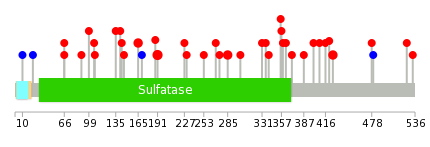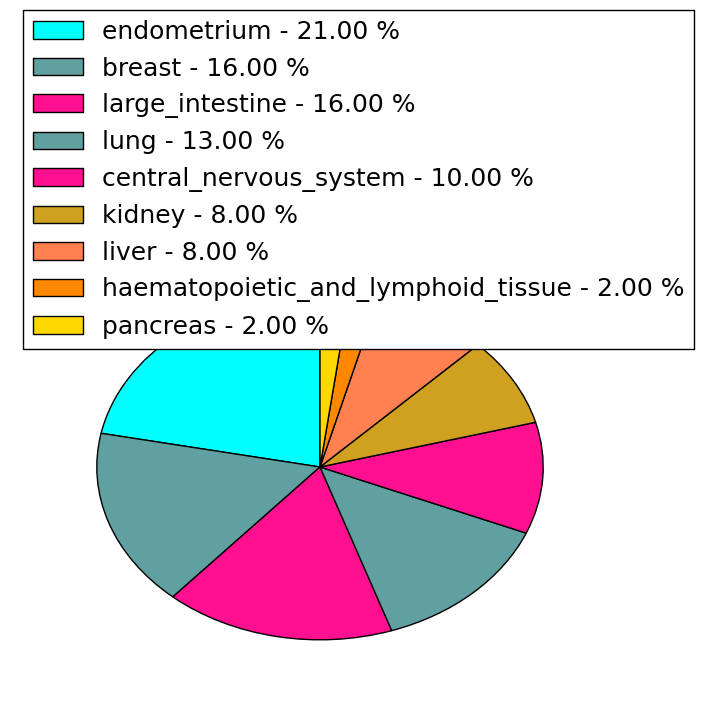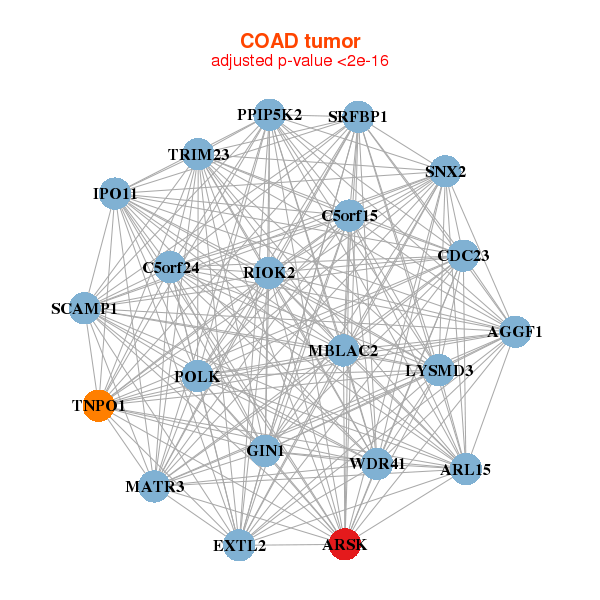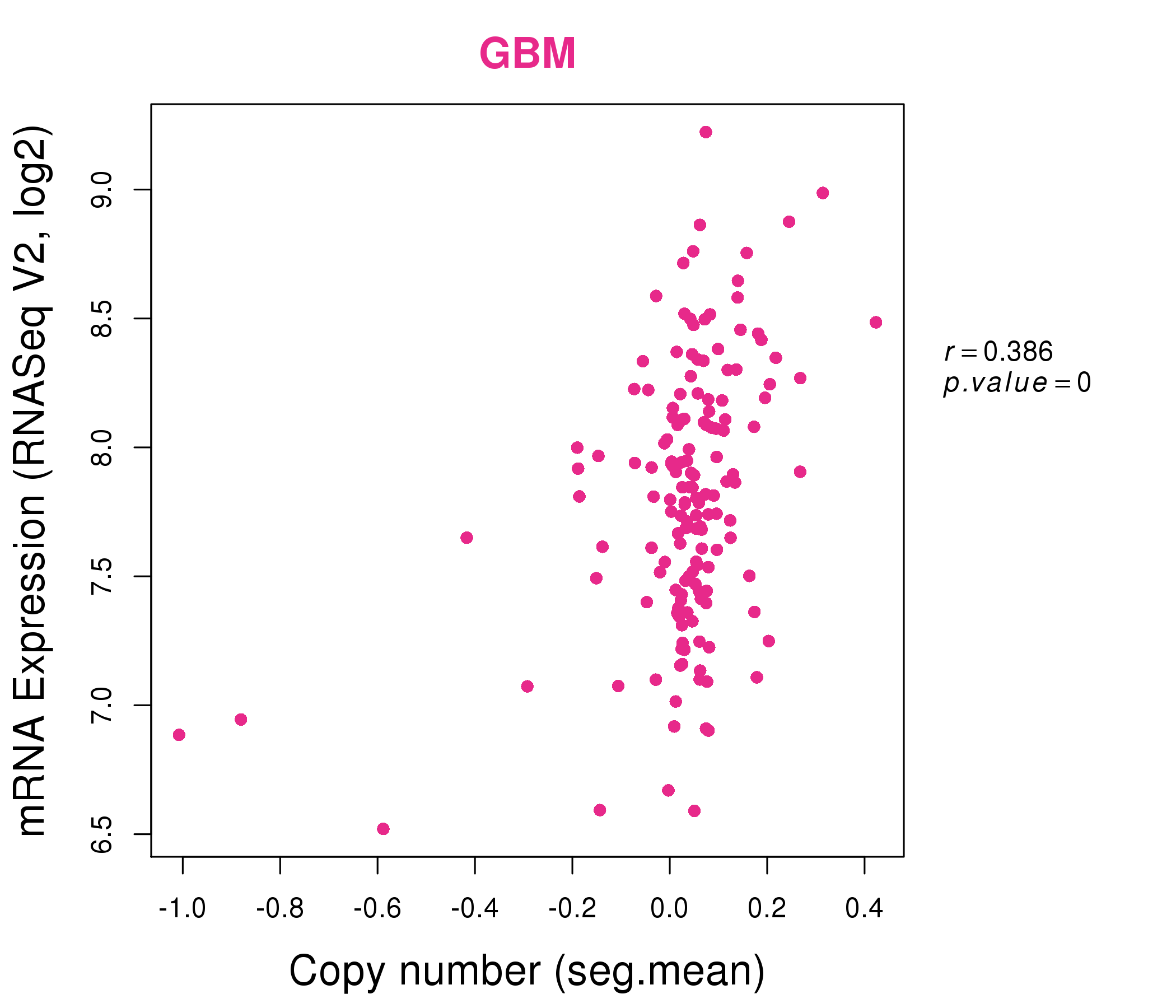|
||||||||||||||||||||||||||||||||||||||||||||||||||||||||||||||||||||||||||||||||||||||||||||||||||||||||||||||||||||||||||||||||||||||||||||||||||||||||||||||||||||||||||||||||||||||||||||||||||||||||||||||||||||||||||||||||||||||||||||||||||||||||||||||||||||||||||||||||||||||||||||||||||||||||||||||||||||||||||
| |
| Phenotypic Information (metabolism pathway, cancer, disease, phenome) |
| |
| |
| Gene-Gene Network Information: Co-Expression Network, Interacting Genes & KEGG |
| |
|
| Gene Summary for ARSK |
| Basic gene info. | Gene symbol | ARSK |
| Gene name | arylsulfatase family, member K | |
| Synonyms | TSULF | |
| Cytomap | UCSC genome browser: 5q15 | |
| Genomic location | chr5 :94890824-94940806 | |
| Type of gene | protein-coding | |
| RefGenes | NM_198150.2, | |
| Ensembl id | ENSG00000164291 | |
| Description | ASKarylsulfatase Ktelethon sulfatase | |
| Modification date | 20141207 | |
| dbXrefs | MIM : 610011 | |
| HGNC : HGNC | ||
| Ensembl : ENSG00000164291 | ||
| HPRD : 13183 | ||
| Vega : OTTHUMG00000121166 | ||
| Protein | UniProt: go to UniProt's Cross Reference DB Table | |
| Expression | CleanEX: HS_ARSK | |
| BioGPS: 153642 | ||
| Gene Expression Atlas: ENSG00000164291 | ||
| The Human Protein Atlas: ENSG00000164291 | ||
| Pathway | NCI Pathway Interaction Database: ARSK | |
| KEGG: ARSK | ||
| REACTOME: ARSK | ||
| ConsensusPathDB | ||
| Pathway Commons: ARSK | ||
| Metabolism | MetaCyc: ARSK | |
| HUMANCyc: ARSK | ||
| Regulation | Ensembl's Regulation: ENSG00000164291 | |
| miRBase: chr5 :94,890,824-94,940,806 | ||
| TargetScan: NM_198150 | ||
| cisRED: ENSG00000164291 | ||
| Context | iHOP: ARSK | |
| cancer metabolism search in PubMed: ARSK | ||
| UCL Cancer Institute: ARSK | ||
| Assigned class in ccmGDB | C | |
| Top |
| Phenotypic Information for ARSK(metabolism pathway, cancer, disease, phenome) |
| Cancer | CGAP: ARSK |
| Familial Cancer Database: ARSK | |
| * This gene is included in those cancer gene databases. |
|
|
|
|
|
| . | ||||||||||||||||||||||||||||||||||||||||||||||||||||||||||||||||||||||||||||||||||||||||||||||||||||||||||||||||||||||||||||||||||||||||||||||||||||||||||||||||||||||||||||||||||||||||||||||||||||||||||||||||||||||||||||||||||||||||||||||||||||||||||||||||||||||||||||||||||||||||||||||||||||||||||||||||||||
Oncogene 1 | Significant driver gene in | |||||||||||||||||||||||||||||||||||||||||||||||||||||||||||||||||||||||||||||||||||||||||||||||||||||||||||||||||||||||||||||||||||||||||||||||||||||||||||||||||||||||||||||||||||||||||||||||||||||||||||||||||||||||||||||||||||||||||||||||||||||||||||||||||||||||||||||||||||||||||||||||||||||||||||||||||||||||||
| cf) number; DB name 1 Oncogene; http://nar.oxfordjournals.org/content/35/suppl_1/D721.long, 2 Tumor Suppressor gene; https://bioinfo.uth.edu/TSGene/, 3 Cancer Gene Census; http://www.nature.com/nrc/journal/v4/n3/abs/nrc1299.html, 4 CancerGenes; http://nar.oxfordjournals.org/content/35/suppl_1/D721.long, 5 Network of Cancer Gene; http://ncg.kcl.ac.uk/index.php, 1Therapeutic Vulnerabilities in Cancer; http://cbio.mskcc.org/cancergenomics/statius/ |
| REACTOME_GLYCOSPHINGOLIPID_METABOLISM REACTOME_PHOSPHOLIPID_METABOLISM REACTOME_METABOLISM_OF_PROTEINS REACTOME_SPHINGOLIPID_METABOLISM REACTOME_METABOLISM_OF_LIPIDS_AND_LIPOPROTEINS | |
| OMIM | |
| Orphanet | |
| Disease | KEGG Disease: ARSK |
| MedGen: ARSK (Human Medical Genetics with Condition) | |
| ClinVar: ARSK | |
| Phenotype | MGI: ARSK (International Mouse Phenotyping Consortium) |
| PhenomicDB: ARSK | |
| Mutations for ARSK |
| * Under tables are showing count per each tissue to give us broad intuition about tissue specific mutation patterns.You can go to the detailed page for each mutation database's web site. |
| There's no structural variation information in COSMIC data for this gene. |
| * From mRNA Sanger sequences, Chitars2.0 arranged chimeric transcripts. This table shows ARSK related fusion information. |
| ID | Head Gene | Tail Gene | Accession | Gene_a | qStart_a | qEnd_a | Chromosome_a | tStart_a | tEnd_a | Gene_a | qStart_a | qEnd_a | Chromosome_a | tStart_a | tEnd_a |
| Top |
| Mutation type/ Tissue ID | brca | cns | cerv | endome | haematopo | kidn | Lintest | liver | lung | ns | ovary | pancre | prost | skin | stoma | thyro | urina | |||
| Total # sample | 1 | 1 | ||||||||||||||||||
| GAIN (# sample) | 1 | 1 | ||||||||||||||||||
| LOSS (# sample) |
| cf) Tissue ID; Tissue type (1; Breast, 2; Central_nervous_system, 3; Cervix, 4; Endometrium, 5; Haematopoietic_and_lymphoid_tissue, 6; Kidney, 7; Large_intestine, 8; Liver, 9; Lung, 10; NS, 11; Ovary, 12; Pancreas, 13; Prostate, 14; Skin, 15; Stomach, 16; Thyroid, 17; Urinary_tract) |
| Top |
|
 |
| Top |
| Stat. for Non-Synonymous SNVs (# total SNVs=37) | (# total SNVs=2) |
 |  |
(# total SNVs=2) | (# total SNVs=0) |
 |
| Top |
| * When you move the cursor on each content, you can see more deailed mutation information on the Tooltip. Those are primary_site,primary_histology,mutation(aa),pubmedID. |
| GRCh37 position | Mutation(aa) | Unique sampleID count |
| chr5:94918775-94918775 | p.A191V | 3 |
| chr5:94927197-94927197 | p.R322* | 3 |
| chr5:94936730-94936730 | p.Y426H | 2 |
| chr5:94918696-94918696 | p.R165C | 2 |
| chr5:94922421-94922421 | p.E285D | 2 |
| chr5:94927224-94927224 | p.E331K | 1 |
| chr5:94903741-94903741 | p.H135L | 1 |
| chr5:94936677-94936677 | p.H408P | 1 |
| chr5:94918892-94918892 | p.W230L | 1 |
| chr5:94927239-94927239 | p.V336I | 1 |
| Top |
|
 |
| Point Mutation/ Tissue ID | 1 | 2 | 3 | 4 | 5 | 6 | 7 | 8 | 9 | 10 | 11 | 12 | 13 | 14 | 15 | 16 | 17 | 18 | 19 | 20 |
| # sample | 2 | 3 | 1 | 2 | 2 | 1 | 1 | 4 | 3 | 6 | 5 | 1 | 3 | |||||||
| # mutation | 2 | 3 | 2 | 2 | 2 | 1 | 1 | 4 | 3 | 6 | 5 | 1 | 3 | |||||||
| nonsynonymous SNV | 1 | 3 | 2 | 2 | 2 | 1 | 1 | 2 | 3 | 5 | 5 | 1 | 2 | |||||||
| synonymous SNV | 1 | 2 | 1 | 1 |
| cf) Tissue ID; Tissue type (1; BLCA[Bladder Urothelial Carcinoma], 2; BRCA[Breast invasive carcinoma], 3; CESC[Cervical squamous cell carcinoma and endocervical adenocarcinoma], 4; COAD[Colon adenocarcinoma], 5; GBM[Glioblastoma multiforme], 6; Glioma Low Grade, 7; HNSC[Head and Neck squamous cell carcinoma], 8; KICH[Kidney Chromophobe], 9; KIRC[Kidney renal clear cell carcinoma], 10; KIRP[Kidney renal papillary cell carcinoma], 11; LAML[Acute Myeloid Leukemia], 12; LUAD[Lung adenocarcinoma], 13; LUSC[Lung squamous cell carcinoma], 14; OV[Ovarian serous cystadenocarcinoma ], 15; PAAD[Pancreatic adenocarcinoma], 16; PRAD[Prostate adenocarcinoma], 17; SKCM[Skin Cutaneous Melanoma], 18:STAD[Stomach adenocarcinoma], 19:THCA[Thyroid carcinoma], 20:UCEC[Uterine Corpus Endometrial Carcinoma]) |
| Top |
| * We represented just top 10 SNVs. When you move the cursor on each content, you can see more deailed mutation information on the Tooltip. Those are primary_site, primary_histology, mutation(aa), pubmedID. |
| Genomic Position | Mutation(aa) | Unique sampleID count |
| chr5:94918696 | p.R165C | 2 |
| chr5:94918775 | p.A191V | 2 |
| chr5:94936730 | p.S227Y | 1 |
| chr5:94918640 | p.Y426H | 1 |
| chr5:94927239 | p.W230L | 1 |
| chr5:94938983 | p.K455T | 1 |
| chr5:94927256 | p.K269E | 1 |
| chr5:94939059 | p.V480V | 1 |
| chr5:94890989 | p.L3L | 1 |
| chr5:94918713 | p.A10A | 1 |
| * Copy number data were extracted from TCGA using R package TCGA-Assembler. The URLs of all public data files on TCGA DCC data server were gathered on Jan-05-2015. Function ProcessCNAData in TCGA-Assembler package was used to obtain gene-level copy number value which is calculated as the average copy number of the genomic region of a gene. |
 |
| cf) Tissue ID[Tissue type]: BLCA[Bladder Urothelial Carcinoma], BRCA[Breast invasive carcinoma], CESC[Cervical squamous cell carcinoma and endocervical adenocarcinoma], COAD[Colon adenocarcinoma], GBM[Glioblastoma multiforme], Glioma Low Grade, HNSC[Head and Neck squamous cell carcinoma], KICH[Kidney Chromophobe], KIRC[Kidney renal clear cell carcinoma], KIRP[Kidney renal papillary cell carcinoma], LAML[Acute Myeloid Leukemia], LUAD[Lung adenocarcinoma], LUSC[Lung squamous cell carcinoma], OV[Ovarian serous cystadenocarcinoma ], PAAD[Pancreatic adenocarcinoma], PRAD[Prostate adenocarcinoma], SKCM[Skin Cutaneous Melanoma], STAD[Stomach adenocarcinoma], THCA[Thyroid carcinoma], UCEC[Uterine Corpus Endometrial Carcinoma] |
| Top |
| Gene Expression for ARSK |
| * CCLE gene expression data were extracted from CCLE_Expression_Entrez_2012-10-18.res: Gene-centric RMA-normalized mRNA expression data. |
 |
| * Normalized gene expression data of RNASeqV2 was extracted from TCGA using R package TCGA-Assembler. The URLs of all public data files on TCGA DCC data server were gathered at Jan-05-2015. Only eight cancer types have enough normal control samples for differential expression analysis. (t test, adjusted p<0.05 (using Benjamini-Hochberg FDR)) |
 |
| Top |
| * This plots show the correlation between CNV and gene expression. |
: Open all plots for all cancer types
 |
|
 |
|
| Top |
| Gene-Gene Network Information |
| * Co-Expression network figures were drawn using R package igraph. Only the top 20 genes with the highest correlations were shown. Red circle: input gene, orange circle: cell metabolism gene, sky circle: other gene |
: Open all plots for all cancer types
 |
|
| AP3B1,APC,ARSK,ERBB2IP,ERCC8,FAM172A,FER, LYSMD3,MFAP3,PJA2,POLK,RBM27,RFESD,SLC25A46, SMAD5,SRFBP1,TMEM167A,TTC37,UTP15,WDR36,YIPF5 | ARSK,C18orf54,CNOT6L,CUL4B,ZC2HC1A,FNDC3A,GOPC, C2CD5,KLHL7,KLHL9,PAPOLG,PDS5B,PUM2,RNF38, RSBN1,SCAMP1,STAG2,TCF12,WDR48,ZMYM1,ZNF615 |
 |
|
| AGGF1,ARL15,ARSK,C5orf15,C5orf24,CDC23,EXTL2, GIN1,IPO11,LYSMD3,MATR3,MBLAC2,POLK,PPIP5K2, RIOK2,SCAMP1,SNX2,SRFBP1,TNPO1,TRIM23,WDR41 | ARSK,ATL2,NREP,CLIC4,EXTL2,FAM171B,HECTD2, HLTF,HSF2,KDELC1,KLHL7,LANCL1,LOC728819,NT5M, RECK,TMEM47,TRAM1L1,ZFP28,ZNF519,ZNF569,ZNF677 |
| * Co-Expression network figures were drawn using R package igraph. Only the top 20 genes with the highest correlations were shown. Red circle: input gene, orange circle: cell metabolism gene, sky circle: other gene |
: Open all plots for all cancer types
| Top |
: Open all interacting genes' information including KEGG pathway for all interacting genes from DAVID
| Top |
| Pharmacological Information for ARSK |
| There's no related Drug. |
| Top |
| Cross referenced IDs for ARSK |
| * We obtained these cross-references from Uniprot database. It covers 150 different DBs, 18 categories. http://www.uniprot.org/help/cross_references_section |
: Open all cross reference information
|
Copyright © 2016-Present - The Univsersity of Texas Health Science Center at Houston @ |









